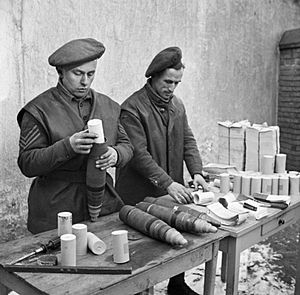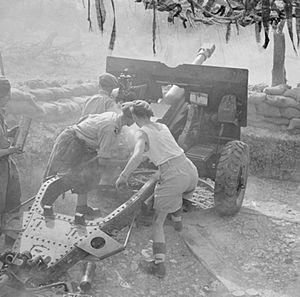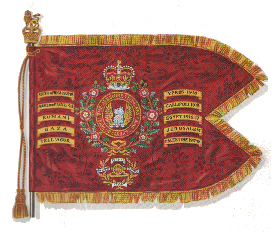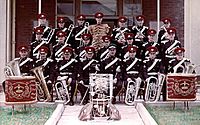Ayrshire (Earl of Carrick's Own) Yeomanry facts for kids
Quick facts for kids Ayrshire (Earl of Carrick's Own) Yeomanry |
|
|---|---|
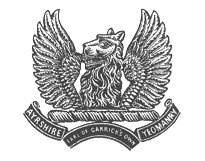
Badge of The Ayrshire Yeomanry
|
|
| Active | 1794–present |
| Country | |
| Branch | |
| Type | Yeomanry |
| Role | Light Cavalry |
| Size | One squadron |
| Part of | Royal Armoured Corps |
| Garrison/HQ | Ayr |
| March | Garb of Old Gaul |
| Engagements | Second Boer War First World War
|
| Battle honours | See battle honours below |
| Commanders | |
| Honorary Colonel | Lieutenant Colonel Ewart L. Baxter, TD |
| Insignia | |
| Stable Belt Colours |  |
The Ayrshire (Earl of Carrick's Own) Yeomanry was once a special British Army unit. It was part of the Yeomanry, which were like volunteer soldiers, often on horseback. Today, it's an armoured squadron within the Scottish and North Irish Yeomanry. This unit is part of the British Army Reserve, meaning its members are part-time soldiers.
The Ayrshire Yeomanry has a long history, going back to the 1790s. It is the only Royal Armoured Corps unit in the Lowlands of Scotland. The squadron is part of 51st (Scottish) Brigade. They are trained for scouting and reconnaissance. They use special Land Rover Wolf vehicles with powerful machine guns. When needed, they join regular army units. Soldiers from this unit have served in places like Afghanistan (Operation HERRICK) and Iraq (Operation TELIC). The Ayrshire Yeomanry has won many special awards called battle honours, and one of its members even won the Victoria Cross, the highest award for bravery.
Contents
History of the Ayrshire Yeomanry
How the Unit Started
The Ayrshire (Earl of Carrick's Own) Yeomanry began around 1794. It was formed by the Earl of Cassillis as a group of volunteer horse soldiers called Fencible Cavalry. They were officially added to the Army in 1798. At this time, Britain needed to protect itself from a possible invasion by French forces led by Napoleon.
In its early years, the regiment helped keep peace. They helped control riots in Ayrshire and other areas, like Paisley. In 1897, they were allowed to use the special name "Earl of Carrick's Own." This honored the future King Edward VII, as "Earl of Carrick" is a title used by the Prince of Wales.
Serving in the Second Boer War
Yeomanry units were not usually sent to fight overseas. However, in December 1899, the British government needed more soldiers for the Second Boer War in South Africa. So, volunteer forces were allowed to serve abroad. The Ayrshire Yeomanry, along with the Lanarkshire Yeomanry, helped create a company of about 115 men. This group was part of the Imperial Yeomanry.
When they returned in 1901, the regiment changed. They became "mounted infantry," meaning they rode horses but fought on foot. They were then called the Ayrshire (Earl of Carrick's Own) Imperial Yeomanry. In 1908, they joined the new Territorial Force and went back to being cavalry. Their base was in Ayr at Wellington Square.
The First World War (1914-1918)
When the First World War started in 1914, many members of the Territorial Force volunteered to serve overseas. Because of this, units were split. The "1st Line" units went overseas, and the "2nd Line" units stayed home. A "3rd Line" was also formed to train new soldiers.
1st Line Ayrshire Yeomanry
The regiment quickly got ready when the war began. They stayed in the United Kingdom until 1915, helping with home defense. In September 1915, they went overseas to the Gallipoli landings. There, they fought as infantry (foot soldiers). After Gallipoli, they moved to Egypt in 1916.
In 1917, the regiment joined with the Lanarkshire Yeomanry. They formed the 12th Battalion of the Royal Scots Fusiliers. They fought in the Palestine campaign before moving to the Western Front in France in May 1918. A soldier from this unit, Thomas Caldwell, won the Victoria Cross on October 31, 1918, in Belgium.
2nd Line Ayrshire Yeomanry
The 2nd Line regiment was formed in 1914 and stayed in Scotland for home defense. In 1916, many Yeomanry units changed to become cyclists. So, the Ayrshire Yeomanry also became a cyclist unit. Later, around May 1918, they moved to Ireland.
Between the World Wars
After the First World War, there were many changes in the army. It was clear that horse cavalry was no longer as important. The Ayrshire Yeomanry was one of the few regiments that remained as horse cavalry.
The Second World War (1939-1945)
Before the Second World War, the regiment trained as horse cavalry in Scotland. However, when the war started, they were needed for a different role. In 1940, the Ayrshire Yeomanry became part of the Royal Artillery. They formed two units of Field Artillery: the 151st and 152nd (Ayrshire Yeomanry) Field Regiments.
151st Field Regiment, Royal Artillery
The 151st Regiment stayed in the United Kingdom until 1942. Then, they went to fight in the Tunisia Campaign in North Africa. In 1944, they joined the 11th Armoured Division. They fought with this division through the campaign in North-Western Europe.
152nd Field Regiment, Royal Artillery
The 152nd Regiment joined the 6th Armoured Division in 1942. They moved to North Africa in November of that year. They stayed with this division for the rest of the war. They fought in the Tunisia Campaign and the Italian Campaign, ending the war in Austria.
Both regiments showed great bravery. Together, they won many awards, including four Distinguished Service Orders and twenty-one Military Crosses.
After the Wars
After the Second World War, the regiment became a Yeomanry Regiment again. It was called The Ayrshire (Earl of Carrick's Own) Yeomanry and joined the Royal Armoured Corps. They used different types of equipment, including flamethrower tanks at one point. The regiment had units in Ayr, Dalry, and Kilmarnock.
In 1961, the Ayrshire Yeomanry received its first Guidon. This is a special flag that shows the unit's battle honours. In 1969, the regiment was reduced to a very small group of men. However, in 1971, this group helped create two new units. One was B Squadron of the 2nd Armoured Car Regiment (later called the Queen's Own Yeomanry). The other was 251 Squadron of 154th (Lowland) Transport Regiment.
In 1992, the squadron joined the new Scottish Yeomanry. Then, in 1999, the Scottish Yeomanry joined with the Queen's Own Yeomanry. Two of the Scottish Yeomanry's squadrons, including the Ayrshire Yeomanry, continued to operate. On July 1, 2014, the squadron left the Queen's Own Yeomanry to form the Scottish and North Irish Yeomanry. Today, they are a 'light cavalry' unit, using their special Land Rover vehicles.
Where the Unit is Based
A (Ayrshire (Earl of Carrick's Own) Yeomanry) Squadron is based at Yeomanry House on Chalmers Road in Ayr.
Battle Honours and Awards

The Ayrshire Yeomanry has been given many special awards called battle honours. These are given for bravery and success in battles. The honours shown in bold are displayed on the regiment's special flag, the Guidon.
- Second Boer War: South Africa 1900–02
- First World War: Ypres 1918, France and Flanders 1918, Gallipoli 1915, Rumani, Egypt 1916–17, Gaza, Jerusalem, Tell 'Asur, Palestine 1917–18
- Second World War: The Royal Artillery, which the Yeomanry was part of, fought in almost all battles. Instead of specific battle honours, they received a special "Honorary Distinction." This is the badge of the Royal Regiment of Artillery with the years "1942–45" and three scrolls for "North-West Europe", "North Africa", and "Italy".
The Guidon Flag
The Guidon is the special flag of The Ayrshire (Earl of Carrick's Own) Yeomanry. It was presented on June 24, 1961, at Culzean Castle, Ayrshire. The battle honours listed above are shown on both sides of this flag.
Under the main part of the flag, there is also the Honorary Distinction for the Second World War. It shows the badge of the Royal Regiment of Artillery with the years "1942-45" and the areas "NW EUROPE," "N AFRICA," and "ITALY."
Victoria Cross Winner
Only one member of the regiment has won the Victoria Cross. This is the highest award for bravery in the British military. The person was Thomas Caldwell. He earned it on October 31, 1918, in Oudenaarde, Belgium.
Uniforms Over Time
Before 1893, the Ayrshire Yeomanry wore dark blue uniforms with red parts. They had black leather helmets and black feathers. Later, they changed to a hussar-style uniform. This included a fur hat called a busby with a white feather. Officers had fancy gold braiding on their jackets. After the Boer War, they wore simpler uniforms. By 1911, they wore plain khaki (a greenish-brown color) uniforms.
Regimental Music
The Ayrshire Yeomanry has a special song called "The Proud Trooper." It was written as a poem after the regiment's actions in South Africa. The first part of the song is often sung to the tune of "Amazing Grace."
Here are the words to the first part of "The Proud Trooper":
-
- "I’ve Listed in The County Horse,
- A Yeoman don’t you know,
- With spurs of steel upon my heel,
- full swagger now I go,
- I’ve sworn an oath to serve the Queen,
- And to defend Her Throne,
- I’m proud to be a Trooper in,
- The Earl of Carrick’s Own."
The Ayrshire Yeomanry Locomotive
There were 842 "Black Fives" locomotives, which were a type of train engine. Only four of them were given names, and these names honored Scottish Regiments. One of these special trains was named "Ayrshire Yeomanry." The others were named after the Lanarkshire Yeomanry, The Queens Edinburgh, Glasgow Highlander, and Glasgow Yeomanry.
Alliances
See also
- Imperial Yeomanry
- List of Yeomanry Regiments 1908
- Yeomanry
- Yeomanry order of precedence
- British yeomanry during the First World War
- Second line yeomanry regiments of the British Army
- List of British Army Yeomanry Regiments converted to Royal Artillery



